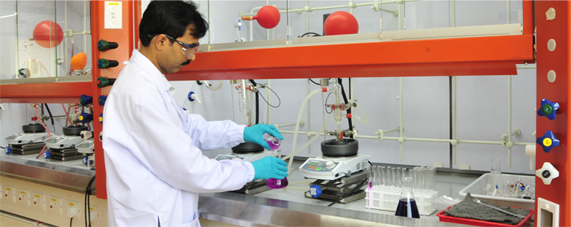
Research and Development (R&D) is the innovation engine of Syngenta and is crucial to driving growth. We want to maintain a high rate of new product delivery to the end of the decade while investing in targeted early research that will deliver breakthrough innovation post-2020. With around 5,000 employees in R&D globally, we continue to search for new and improved ways of raising the quality and yield of crops worldwide.
In 2014, we invested $1.43 billion in R&D globally and our programs focused on innovation to increase yields, quality, protect plants and improve resource efficiency in the field – by developing products and practices that reduce the land, water and energy needed to grow crops. Product safety and environmental considerations are also integral to our work. For every crop protection product that reaches the farmer’s field almost 100,000 are tested but discarded because they don’t meet our efficacy or safety standards.
We have a diverse and balanced portfolio of chemicals, genetics and integrated solutions for all our major crops. It is refreshed by constant innovation – to solve new problems and address old problems with new solutions that are more effective, safer or add more value. Complementing our internal resources through partnerships is a key element in our R&D strategy. We strategically collaborate with universities, institutes and companies at the forefront of technology development to solve agricultural challenges.
Our Crop Protection research focuses on developing a range of herbicides, fungicides, insecticides and crop enhancing chemicals with broad applicability such as foliar, soil and seed treatments. Our Seeds research and development program focuses on creating new varieties of major field crops, which include improved quality and productivity. This can include greater resistance to pests and diseases, or other environmental stresses, as well as characteristics such as improved customer appeal or enhanced shelf life.
In India we aim to get new innovations in the hands of growers to enhance their productivity in key crops like rice, vegetables, corn, wheat, cotton etc. We have many innovative water-efficient technologies, drought-tolerant seeds and optimized irrigation systems that can tackle the vagaries of weather. Our vegetable hybrids can withstand climate changes and grow throughout the year in subtropical or temperate conditions. The advancements in research have enabled a fruit like watermelon to be grown in all seasons. Syngenta has corn hybrids that use moisture more efficiently to give higher yields on drought-stressed land. There are Herbicides that reduce the need for plowing improving soil’s ability to absorb water, protecting it against erosion and water run-off.
Syngenta has established a large network of crop protection and seeds field research stations, sophisticated R&D facilities and laboratories and seeds production sites across the India.

R&D Station

R&D Field Stations

Research and Technology Centre, Goa

INDIA MAP OF LOCATIONS FROM ARTWORK
